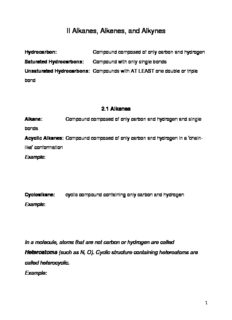
II Alkanes, Alkenes, and Alkynes - School of Chemistry and PDF
Preview II Alkanes, Alkenes, and Alkynes - School of Chemistry and
II Alkanes, Alkenes, and Alkynes Hydrocarbon: Compound composed of only carbon and hydrogen Saturated Hydrocarbons: Compound with only single bonds Unsaturated Hydrocarbons: Compounds with AT LEAST one double or triple bond 2.1 Alkanes Alkane: Compound composed of only carbon and hydrogen and single bonds Acyclic Alkanes: Compound composed of only carbon and hydrogen in a 'chain- like' conformation Example: Cycloalkane: cyclic compound containing only carbon and hydrogen Example: In a molecule, atoms that are not carbon or hydrogen are called Heteroatoms (such as N, O). Cyclic structure containing heteroatoms are called heterocyclic. Example: 1 2.1.1 Isomers, Nomenclature, and Conformations of Alkanes Basic Alkanes (cid:222) chain like molecules based on C and H with NO branch Branched Alkanes: Alkanes that have carbons that are bonded to more than 2 carbons (these are skeletal isomers) Example Butane: Primary Carbon: Carbon bonded to only ONE other carbon (1(cid:176) ) Secondary Carbon: Carbon bonded to TWO other carbons (2(cid:176) ) Tertiary Carbon: Carbon bonded to THREE other carbons (3(cid:176) ) Quaternary Carbon: Carbon bonded to FOUR other carbons (4(cid:176) ) Nomenclature: (cid:222) parent: longest alkyl chain of the molecules fi if two possible chains have the same # of carbons, the one with the more branch points wins (cid:222) suffix: If only alkane, ending is -ane; if molecule has functional groups, they determine the suffix Alkyl Group: Hydrocarbon chain with one open point of attachment often R is used to describe a generic alkyl group Example: 2 Alkyl Groups: Examples of Nomenclature: 3 Conformational Isomers: Isomers that differ as a result of the degree of rotation around a carbon-carbon single bond Let us take Ethane as an example to describe alkane conformation: Conformation or orientations of alkanes can be expressed using several different methods: A) Sawshorse Diagram: A way of representing conformational isomers with stick drawings B) Newman Projection: A way of representing conformational isomers using an end-on projection of a carbon-carbon bond Eclipsed: Conformation around a carbon-carbon single bond in which attached atoms are as close together as possible Staggered: Conformation around a carbon-carbon single bond in which attached atoms are as far apart as possible Torsional or Dihedral Angle: Angle between the bonds in the Newman Projection 4 Example 1,2-Dibromoethane: Q1: Which of these structures is the most stable and why: Example Butane: - Staggered most stable. - Two possibilities, Anti and Gauche 5 2.1.2 Cycloalkanes • Cyclic structure based on Carbon-Carbon single bonds Fused Ring Systems: Several cycles (or rings) share two common atoms and the bond between them Spiro Compound: Two Rings share ONE carbon Bridged Ring Compounds: Two rings share two non-connected atoms, thereby building a bridgehead with bridgehead atoms Examples: Nomenclature: 6 Conformation of Cycloalkanes: Boat Confirmation: An unstable conformation of cyclohexane with 109.5(cid:176) bond angles but in which most bonds are eclipsed Example: Chair Confirmation: The most stable conformation of cyclohexane in which all bonds are staggered and the bond angles are 109.5(cid:176) Example: (cid:222) The hydrogens are either above and below the ring or to the side of the ring Axial Bond: Bond on cyclohexane chain perpendicular to the ring with three up and three down on alternating carbons Equatorial Bonds: Bonds on cyclohexane chair parallel to the ring Cycloalkanes are not restricted to one confirmation but can FLIP between different conformations. This is called Ring Flip. 7 Substituted Cycloalkanes Bulky substituents prefer to be in equatorial position and NOT axial Example Methylcyclohexane: Geometric Isomers: Cis and trans isomers; a type of stereoisomers in which atoms or groups display orientation differences around a double bond or ring Cis Isomer: Geometric isomer in which groups are on the same side of a ring or double bond Trans Isomer: Geometric Isomer in which groups are on the opposite sides of a ring or double bond Example: 8 2.1.3 Properties of Alkanes • Melting and boiling points increase with increased molecular weight (Methane bp. -164(cid:176) C, decane bp. 174(cid:176) C) • Boiling point decrease with chain branching (decrease in surface area) but metling points increase • Non-polar substances (cid:222) not water soluble • Alkanes are less dense than water and swim on top of water 2.1.4 Reactions of Alkanes • In general very un-reactive (cid:222) you need a lot of driving force A) Oxidation Example Methane: B) Halogenation Halogenation (a substitution reaction): Introduction of a halogen into a molecule (chlorination, bromination) General Reaction: • You need heat or light 9 Example Methane: How to control the degree of halogenation? Mechanism: - same as free radical polymerization Where does halogenation takes place? 10
Description: